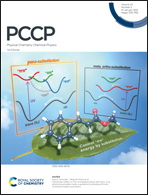An oxygen-passivated vanadium cluster [V@V10O15]− with metal–metal coordination produced by reacting Vn− with O2†
Abstract
Vanadium cluster anions are highly reactive making the preparation of pure Vn− and the observation of their reactivity extremely challenging. Herein, well-resolved anionic Vn− clusters are prepared enabling an in-depth study on their reactions with O2 in the gas phase. While pure metal clusters of a magic number are not identified due to the strong V–O bonding, interestingly an unexpected oxide V11O15− was experimentally observed in surviving O2 etching reactions. First-principles theory calculations indicate that V11O15− possesses a body-centered pentagonal prism structure (D5h,  ), with the V@V10 core fully protected by 15 oxygen bridges. Such an oxygen-protected metal cluster [V@V10O15]− exhibits typical superatom orbital features pertaining to the V@V10 core which shows effective metal–metal coordination bonding. Meanwhile, the high stability of [V@V10O15]− is reinforced by the V–O–V conjugation interactions which help to maintain the structural integrity, resulting in 3D inorganic aromaticity. This finding of such an oxygen-passivated superatom cluster sheds light on the bonding nature in ligand-protected metal clusters via wet synthesis.
), with the V@V10 core fully protected by 15 oxygen bridges. Such an oxygen-protected metal cluster [V@V10O15]− exhibits typical superatom orbital features pertaining to the V@V10 core which shows effective metal–metal coordination bonding. Meanwhile, the high stability of [V@V10O15]− is reinforced by the V–O–V conjugation interactions which help to maintain the structural integrity, resulting in 3D inorganic aromaticity. This finding of such an oxygen-passivated superatom cluster sheds light on the bonding nature in ligand-protected metal clusters via wet synthesis.
![Graphical abstract: An oxygen-passivated vanadium cluster [V@V10O15]− with metal–metal coordination produced by reacting Vn− with O2](/en/Image/Get?imageInfo.ImageType=GA&imageInfo.ImageIdentifier.ManuscriptID=D0CP05385F&imageInfo.ImageIdentifier.Year=2021)


 Please wait while we load your content...
Please wait while we load your content...